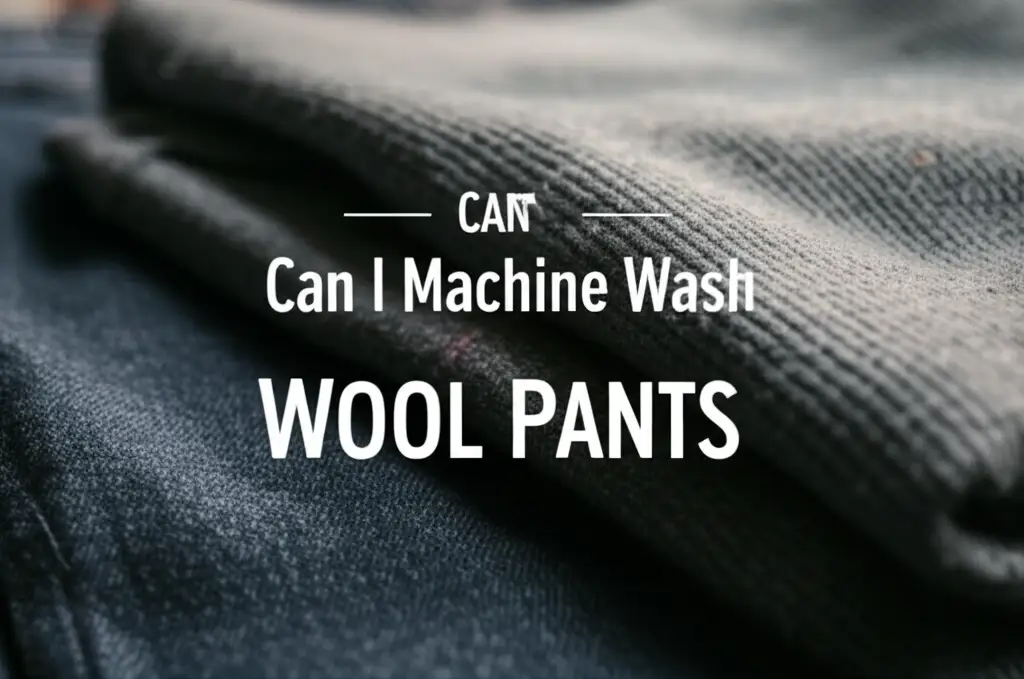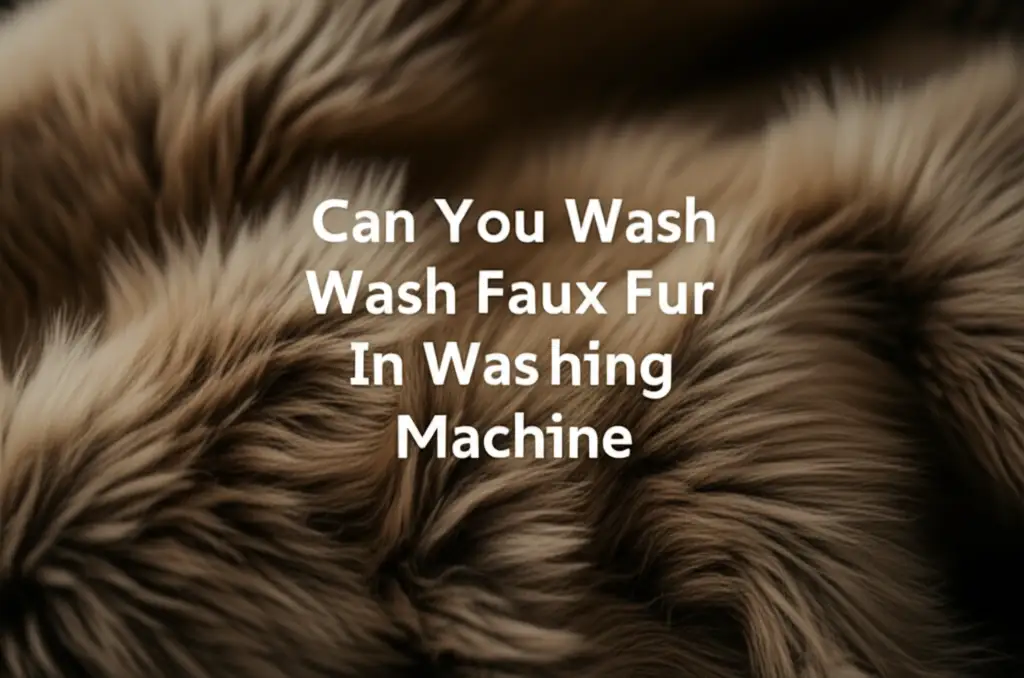· Liora Benning · Fabric Care · 17 min read
Can I Machine Wash Wool Pants

Can I Machine Wash Wool Pants: Your Ultimate Guide to Safe Cleaning
Wool pants are a wonderful addition to any wardrobe. They offer warmth, style, and natural breathability. Many people wonder about their care. A common question I hear is, “Can I machine wash wool pants?” The thought of shrinking or damaging these valuable garments is a real concern. This worry often leads people to dry cleaning, which can be costly and time-consuming.
I understand this dilemma well. Wool fabric is special and needs specific care. The good news is, in many cases, you can machine wash wool pants. This article will explain exactly how to do it safely. We will cover everything from understanding wool fibers to choosing the right machine settings. You will learn about proper drying techniques and when hand washing is a better choice. By the end, you will feel confident caring for your wool trousers at home, saving time and money while keeping them in excellent condition.
Takeaway
- Check the Label: Always read the care tag on your wool pants first.
- Gentle Cycle Only: Use your washing machine’s “wool,” “delicate,” or “hand wash” setting.
- Cold Water is Crucial: Wash wool pants exclusively in cold water to prevent shrinkage.
- Wool-Specific Detergent: Choose a mild, pH-neutral detergent designed for wool or delicates.
- No Tumble Dry: Air dry wool pants by laying them flat to maintain their shape.
Clear Answer
Yes, you can often machine wash wool pants, but it requires careful attention. Always check the care label first. Use a gentle cycle with cold water and a wool-friendly detergent. Never put wool pants in a tumble dryer; instead, reshape them and air dry flat to prevent shrinkage and damage.
Understanding Wool Fabric: Why Care Matters
Wool is a natural fiber, quite different from cotton or synthetics. It comes from sheep and other animals. Each wool fiber has tiny scales on its surface. These scales are the key to understanding how wool behaves. When these scales get agitated or exposed to high heat, they can interlock. This interlocking process is called felting, and it causes wool to shrink.
This unique structure also gives wool its amazing properties. Wool is warm, moisture-wicking, and resists odors. It also has a natural elasticity. Proper care helps preserve these benefits. Without the right washing method, wool pants can lose their shape. They might become stiff or feel rough. My goal is always to keep my wool items feeling soft and looking great.
Many people fear washing wool because of past shrinkage experiences. I’ve learned that most shrinkage happens from heat combined with agitation. A standard washing machine cycle, designed for durable fabrics, uses a lot of both. This is why special care is needed for your valuable wool pants. Understanding the fiber helps you choose the right approach for cleaning. It makes you realize why those specific settings and detergents are so important.
Reading the Care Label: Your First Step
Before you do anything else, check the care label on your wool pants. This small tag provides vital instructions. It is the manufacturer’s guide for keeping your garment in good condition. I always check this label before washing any new item. Sometimes, the label will explicitly say “machine wash wool.” Other times, it might say “hand wash” or “dry clean only.”
If the label says “dry clean only,” it is usually best to follow that advice. This often means the garment’s construction, dyes, or embellishments are not suited for water washing. However, some items labeled “dry clean only” can be carefully hand washed. This is especially true for items made of 100% wool without complex linings or structures. If your pants are a blend, the other fibers might also influence the care. Synthetics like polyester might make the pants more durable, but cotton or rayon blends still need gentle care.
Look for symbols on the tag. A tub with water indicates washing. A tub with a hand means hand wash only. A crossed-out tub means do not wash. A circle means dry clean. Pay attention to the temperature symbols too. Dots inside the tub show the maximum wash temperature. For wool, you usually want the coldest setting available. Always prioritize the care label’s instructions. It helps you avoid costly mistakes and keeps your wool pants looking new.
Preparing Wool Pants for Machine Washing
Proper preparation is vital when you decide to machine wash wool pants. This step helps protect the fabric and ensures an even clean. I always take a few minutes for this preparation. First, empty all pockets. Any items left inside, like coins or tissues, can damage the fabric or the machine. Close all zippers, buttons, and hooks. This prevents them from snagging the wool or other clothes. It also helps the pants keep their shape during the wash cycle.
Next, address any stains. Spot treat stains before putting the pants in the washer. Use a gentle stain remover suitable for wool. Apply a small amount directly to the stain. Gently blot it with a clean cloth. Avoid rubbing vigorously, as this can spread the stain or damage the wool fibers. For stubborn stains, you might consider professional cleaning. It is always better to tackle stains while they are fresh.
Turning your wool pants inside out is another important step. This protects the outer surface of the fabric. It reduces friction during the wash, which can cause pilling. It also helps preserve the color. Lastly, place the pants inside a mesh laundry bag. This bag provides an extra layer of protection. It prevents the pants from stretching or getting tangled with other items. If washing multiple wool items, separate colors. Wash dark colors with darks and lights with lights to prevent dye transfer.
Choosing the Right Settings for Machine Washing Wool Pants
The correct machine settings are the most critical part of washing wool pants. This is where most people go wrong. Selecting the wrong cycle or temperature can quickly ruin your wool. I have learned this through experience.
Selecting the Wash Cycle
Always choose the most gentle cycle on your washing machine. Many modern washing machines have specific “wool” cycles. If yours does, use it. This cycle is designed with minimal agitation and specific pauses to protect delicate fibers. If you do not have a “wool” cycle, select the “delicate” or “hand wash” cycle. These cycles use less agitation and a slower spin speed. This gentler motion prevents the wool fibers from felting and shrinking. Avoid any heavy-duty or regular wash cycles. They are too harsh for wool.
Water Temperature is Key
Cold water is absolutely essential for washing wool pants. Hot water causes wool fibers to felt and shrink irreversibly. I cannot stress this enough. Even warm water can be too risky. Always set your machine to the “cold” water setting for both the wash and rinse cycles. Cold water helps maintain the fabric’s integrity. It also prevents colors from bleeding. This simple step is vital for preventing damage. For more information on what different temperatures mean, you might find this article helpful: What Does 40 Degree Machine Wash Mean.
Detergent Choice Matters
The type of detergent you use also plays a big role. Harsh detergents can strip the natural oils from wool. These oils, like lanolin, keep wool soft and resilient. Use a detergent specifically formulated for wool or delicates. These detergents are pH-neutral and do not contain harsh enzymes or bleaches. Look for labels like “wool wash” or “delicate detergent.” If you cannot find a wool-specific detergent, a mild, pH-neutral baby shampoo can work in a pinch. Avoid using fabric softeners unless they are specifically designed for wool. Some fabric softeners can build up on wool fibers, making them stiff. Caring for delicate fabrics like wool is similar to caring for other fine materials. For tips on washing another delicate fiber, consider reading about Can You Machine Wash Cashmere.
The Gentle Machine Washing Process
Once you have prepared your wool pants and chosen the correct settings, the actual washing process is straightforward. However, a few careful steps can make a big difference. I follow these steps every time I machine wash my wool garments.
First, load your washing machine carefully. Place the wool pants, ideally in their mesh laundry bag, into the drum. Do not overload the machine. Overloading prevents proper cleaning and can increase friction between items. This increased friction can damage delicate wool fibers. Give the pants plenty of space to move freely in the water. This ensures a gentle wash.
Next, add your chosen wool-specific or delicate detergent. Use only the recommended amount. Too much detergent can leave residue on the fabric. Too little might not clean effectively. If your machine has a special dispenser for delicates or liquid detergents, use that. Otherwise, add the detergent directly to the water before adding the pants, if your machine allows. This helps it dissolve evenly.
Start the gentle cycle with cold water. Let the machine run its course. Resist the urge to open the machine or interrupt the cycle. Modern machines are designed to handle delicate cycles with care. Once the wash cycle finishes, remove your wool pants immediately. Do not leave them sitting wet in the machine. Prolonged dampness can lead to wrinkles, mildew, or an unpleasant smell. Handle them gently as you take them out. Avoid pulling or stretching the wet fabric. This helps maintain their original shape.
Drying Wool Pants: Preventing Shrinkage and Damage
Drying wool pants correctly is just as important as washing them. This step is where many people make irreversible mistakes. I have learned to be very cautious during the drying phase to prevent any damage.
No Tumble Drying!
This is the most critical rule for drying wool pants: never, ever put them in a tumble dryer. Tumble dryers use high heat and aggressive tumbling. This combination is guaranteed to cause wool to shrink significantly and felt. Once wool shrinks in a dryer, it is usually impossible to restore its original size and softness. The heat permanently bonds the wool fibers together. Avoid the dryer at all costs.
Gentle Water Removal
After taking your wool pants out of the washing machine, they will be quite damp. Do not wring them out. Wringing can stretch or distort the fabric. Instead, gently press out as much excess water as possible. I often lay a clean, dry towel flat. Then, I place the wool pants on top of the towel. Starting from one end, I carefully roll the towel and the pants together. This helps the towel absorb a lot of the water without stressing the fabric. You can gently press down on the rolled towel to aid absorption.
Air Drying Techniques
Air drying is the only safe way to dry wool pants. The best method is to lay them flat. Find a clean, dry surface, like a drying rack, a clean table, or even a few clean towels spread on the floor. Lay the pants flat on this surface. Carefully reshape them to their original form. Smooth out any wrinkles or creases. Make sure the waist, legs, and seams are aligned properly.
If you hang wool pants to dry, they might stretch out of shape due to their weight when wet. Especially the waist and knees can become distorted. If you must hang them, use a padded hanger and fold them over the hanger bar in half, rather than hanging by the waist. However, laying flat is always preferred. Allow plenty of airflow around the pants. You can flip them periodically to ensure even drying. Drying time will vary depending on humidity and air circulation. Be patient. Your wool pants are worth the wait. For general wool cleaning and drying advice, similar methods apply to items like How Do You Clean an Area Wool Rug.
When Hand Washing is the Better Option
While machine washing wool pants can be done, there are times when hand washing is a much better choice. I often opt for hand washing for my most delicate or expensive wool items. This method offers the most control. It minimizes any risk of damage.
Hand washing is ideal for wool pants labeled “dry clean only” that you are determined to wash at home. It’s also perfect for pants made of very fine wool, like Merino, or those with delicate details. If your washing machine does not have a gentle enough cycle, hand washing becomes the safest alternative.
Here is how I hand wash wool pants:
- Prepare the Basin: Find a clean basin, sink, or tub. Fill it with cool or lukewarm water. Avoid hot water completely.
- Add Detergent: Pour a small amount of wool-specific detergent into the water. Swish it around gently to dissolve it. Do not use too much detergent.
- Submerge Pants: Carefully place your wool pants into the water. Ensure they are fully submerged. Gently press them down to release any trapped air bubbles.
- Gentle Agitation: Swirl the pants in the water for a few minutes. Use very gentle squeezing motions. Do not rub, twist, or stretch the fabric. Focus on allowing the water and detergent to work through the fibers. This minimal agitation prevents felting.
- Rinse Thoroughly: Drain the soapy water. Refill the basin with clean, cool water. Gently press the pants to rinse out the detergent. Repeat this process until all soap residue is gone and the water runs clear. Again, avoid wringing.
- Remove Excess Water: Just like with machine washing, do not wring the pants. Gently press out as much water as you can. Then, roll them in a clean, dry towel to absorb more moisture.
- Air Dry Flat: Lay the wool pants flat on a clean, dry surface or drying rack. Reshape them to their original dimensions. Allow them to air dry completely. Flip them occasionally for even drying.
Hand washing takes a little more time and effort. However, it gives you peace of mind. You know you are treating your wool pants with the utmost care. This method helps maintain their softness, shape, and longevity.
Stain Removal and Pre-Treatment for Wool Pants
Stains on wool pants can be frustrating. However, treating them properly can save your garment. I always recommend addressing stains as soon as possible. Fresh stains are much easier to remove than old, set-in ones. The key is gentle, targeted action.
First, identify the type of stain.
- Liquid Stains (e.g., coffee, wine): Blot the stain immediately with a clean, dry cloth. Do not rub, as this pushes the stain deeper into the fibers. You want to absorb it.
- Solid Stains (e.g., mud, food particles): Let the stain dry completely. Then, gently scrape off any excess material with a dull knife or spoon. Avoid forcing it into the fabric.
Once the initial excess is removed, you can pre-treat the spot. Use a stain remover specifically labeled safe for wool or delicate fabrics. Test the stain remover on an inconspicuous area first, like an inner seam. This ensures it does not discolor or damage the fabric. Apply a small amount of the stain remover directly to the stained area. Gently blot or dab it with a clean cloth. Work from the outside of the stain inwards. This prevents the stain from spreading.
For oily stains, a small amount of mild dish soap can work. Mix a tiny drop with water. Apply it to the stain. Gently blot. Then rinse the area with a damp cloth. For other common stains like ink or grease, you might need specialized wool-safe products. Always follow the product’s instructions. After pre-treating, proceed with either machine washing on a gentle cycle or hand washing, as described earlier. Make sure to rinse the treated area thoroughly. Avoiding harsh chemicals and abrasive scrubbing is crucial. These can damage the delicate wool fibers. Patience and gentle handling are your best tools for successful stain removal on wool pants.
Long-Term Care and Storage of Wool Pants
Caring for your wool pants extends beyond just washing them. Proper long-term care and storage are essential. They help maintain their shape, prevent damage, and keep them looking fresh between washes. I’ve found that these habits significantly extend the life of my wool garments.
Wool pants can wrinkle, especially after sitting. Instead of ironing, which can flatten wool fibers, I prefer steaming. A garment steamer works wonders. It gently relaxes the fibers. This removes wrinkles without direct heat or pressure. If you do not have a steamer, hang the pants in a steamy bathroom while you shower. The humidity will help release wrinkles. Always hang wool pants on sturdy, padded hangers. This prevents creases and maintains their natural drape. Avoid wire hangers, which can leave marks and distort the shape.
Moths are a major enemy of wool. They love to eat natural fibers. To protect your wool pants during storage, ensure they are clean before putting them away. Moths are attracted to dirt and body oils. Store them in breathable garment bags. These bags protect against dust and pests. You can also use natural moth repellents like cedar blocks or lavender sachets. Place these inside the garment bag or closet. Remember to refresh cedar blocks periodically by lightly sanding them to release their scent. For more detailed advice on protecting wool from pests, you can check out How to Get Rid of Months in Wool Rugs.
When storing wool pants for extended periods, especially during warmer months, choose a cool, dry, dark place. Avoid damp basements or attics. Humidity can encourage mildew growth. Folding wool pants for storage is acceptable if space is limited. Fold them neatly along existing creases. Place tissue paper between folds to prevent sharp creases. However, hanging is generally better for maintaining the pant’s form. With these simple storage tips, your wool pants will be ready to wear when you need them.
FAQ Section
Can all wool pants be machine washed?
No, not all wool pants are suitable for machine washing. Always check the care label first. If the label explicitly states “dry clean only,” it is safest to follow that instruction. Some blends or highly structured wool pants might not withstand machine washing, even on a gentle cycle.
What happens if I machine wash wool pants on a hot cycle?
Machine washing wool pants on a hot cycle will almost certainly cause them to shrink and felt. The combination of high heat and agitation causes the wool fibers to irreversibly interlock and compact. This results in a smaller, thicker, and often stiff garment that cannot be restored.
What kind of detergent is best for wool pants?
The best detergent for wool pants is one specifically formulated for wool or delicates. These are typically pH-neutral and free of harsh enzymes, bleaches, and brighteners that can damage wool fibers. Mild baby shampoo can be a substitute in a pinch.
How often should I wash wool pants?
Wool pants do not need frequent washing. Wool naturally resists odors and dirt. Air them out between wears to refresh them. Only wash them when they are visibly dirty, stained, or start to smell. Over-washing can wear out the fibers faster.
Can I use fabric softener on wool pants?
It is generally not recommended to use standard fabric softener on wool pants. Some softeners can build up on wool fibers, leading to stiffness or reduced breathability. If you desire extra softness, look for wool-specific conditioners or simply ensure a thorough rinse with cold water.
How do I fix shrunken wool pants?
Fixing shrunken wool pants is challenging, but sometimes possible. Gently re-wet the garment with lukewarm water and a wool conditioner. Then, carefully stretch the pants back to their original size while wet. Lay them flat to dry, maintaining the stretched shape with weights if needed. This method has varying success.
Conclusion
Caring for your wool pants might seem intimidating at first. Many of us have heard stories of beloved wool items shrinking in the wash. I hope this guide has cleared up the confusion. You can absolutely machine wash wool pants at home. The key is understanding wool’s unique properties and following specific, gentle steps. It is all about giving your beautiful wool trousers the careful attention they deserve.
Remember to always consult the care label first. Use the right washing machine settings—think gentle cycle and cold water only. Choose a wool-friendly detergent to protect those delicate fibers. Most importantly, ditch the tumble dryer. Air drying flat is the golden rule for maintaining shape and preventing shrinkage. By adopting these methods, you can keep your favorite wool pants looking sharp and feeling soft for many years to come. You will save money on dry cleaning, and you will gain confidence in caring for your garments. Go ahead, give your wool pants the home care they deserve!





